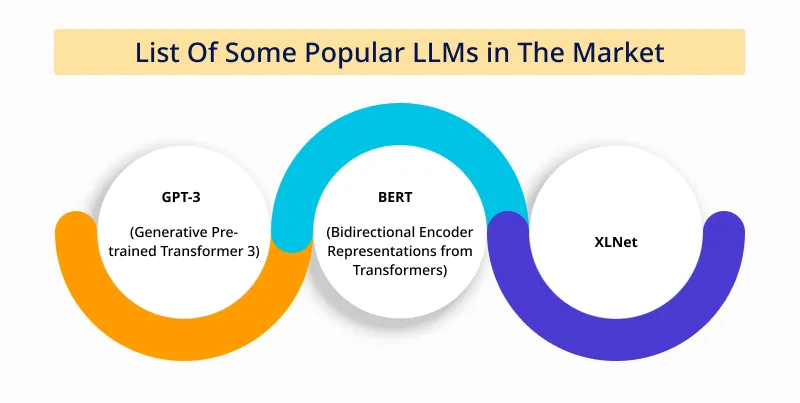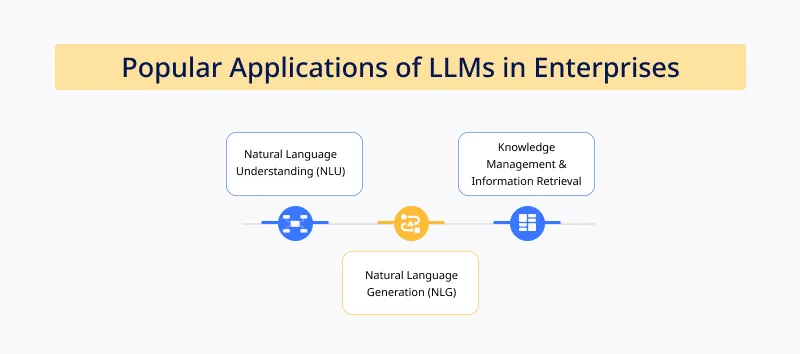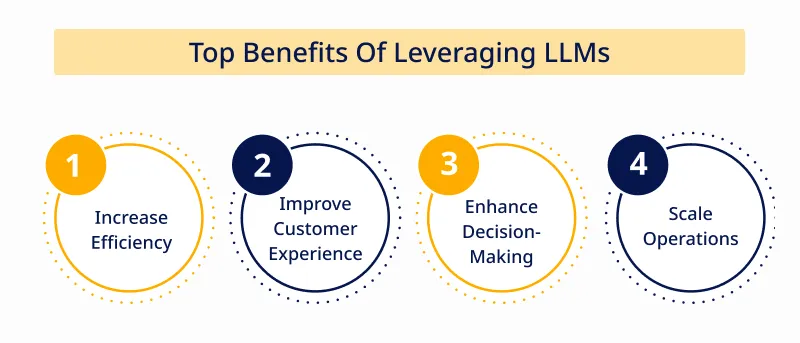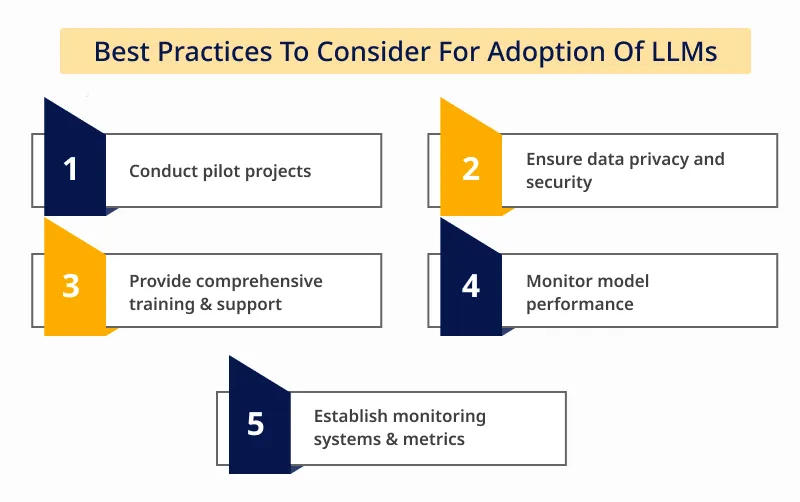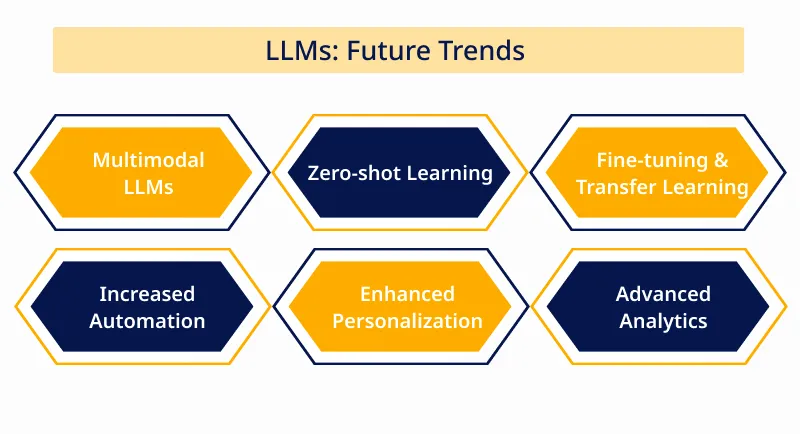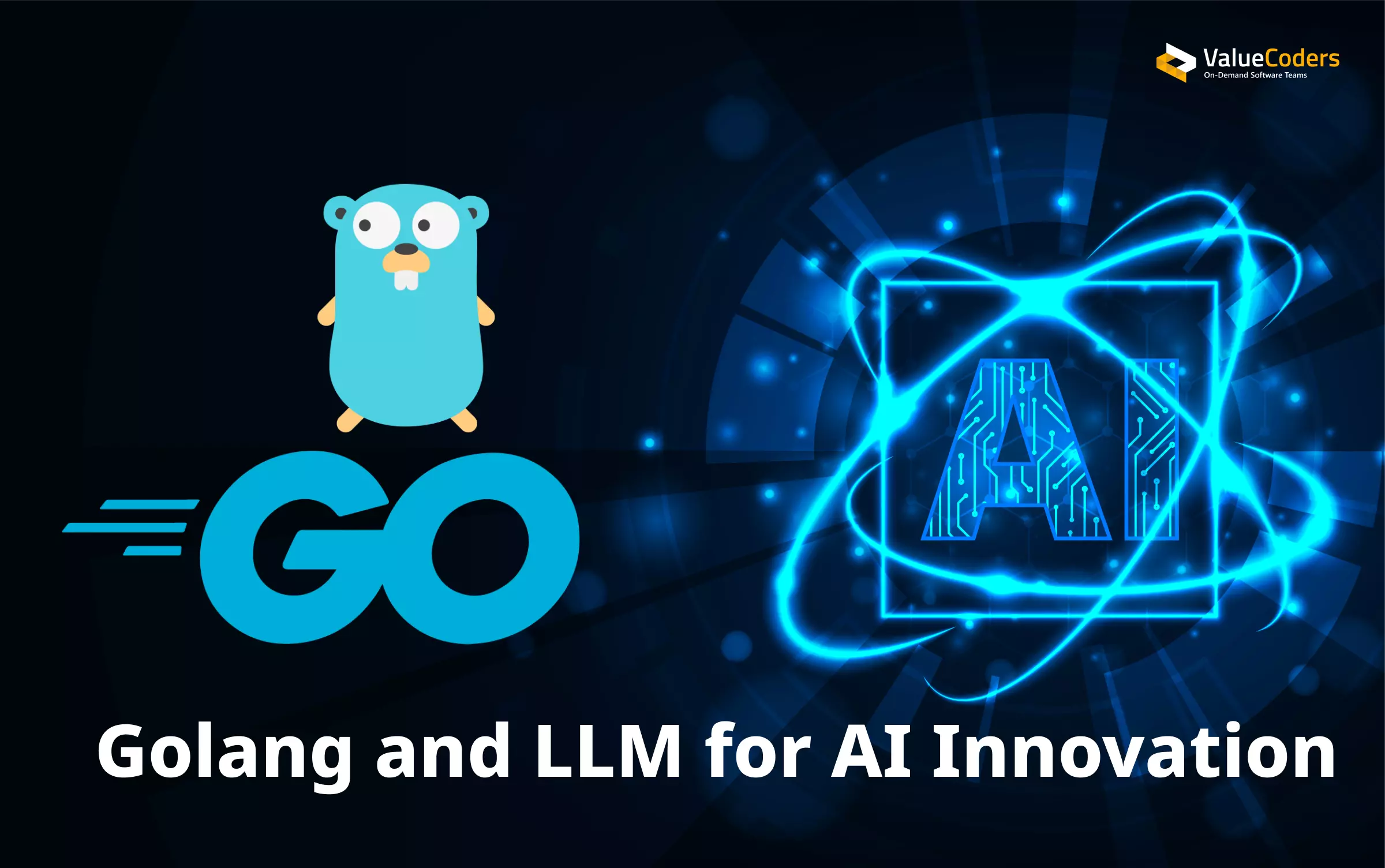Is your enterprise constantly seeking ways to utilize the power of new technologies to maximize business growth & stay ahead of the competition?
If yes, then you’ve landed on the right blog post!
One of the groundbreaking technologies that has captured the attention of forward-thinking businesses is Large language models (LLMs). These are also called sophisticated AI-powered tools.
Large language models for enterprises have remarkable ability to understand & generate human-like text, opening up a world of possibilities for businesses among different industries or sectors.
This detailed post explores the intriguing world of LLMs and understands how enterprises can leverage them to
- Unlock new opportunities
- Streamline operations
- Drive innovation
Let’s find out the transformative potential of LLMs for businesses of all types!
An Overview of Large Language Models
Large language models for enterprises are advanced artificial intelligence systems trained on vast amounts of text data from the internet. By using some sophisticated algorithms, these models
- Learn the intricacies of human language
- Understand, interpret, and generate text with remarkable accuracy
- Answer questions and summarize documents to translate languages
- Generate creative content
Once trained, LLMs become ready to deploy for various enterprise applications, including natural language understanding, natural language generation, machine translation, sentiment analysis, and more.
Hence, LLMs have a wide range of capabilities that make them invaluable assets & offer top AI solutions for enterprises.
Some Popular LLMs in the market include:
- GPT-3
- BERT
- XLNet
Each LLM offers unique capabilities and features tailored to different use cases and industries.
So, enterprises can choose the LLM that best suits their specific needs & objectives when leveraging the power of Artificial Intelligence services to enhance their operations, improve customer experiences, and drive innovation in today’s digital landscape.
Harness the potential of LLMs for your enterprise.
How To Build Large Language Models for Enterprises?
Building Large language models for enterprises can be extremely time-consuming and resource-exhaustive task. Hence, most enterprises are likely to opt for customizing existing models to their needs.
Customizing existing base models (also called pre-trained models or PLMs) can be typically split into 3 essential steps:
1. Finding a well-suited foundation model (PLM): This requires considering the ideal model size, training tasks and datasets, LLM providers, and more.
2. Fine-tuning the model: Base models can be fine-tuned on a specific corpus and for a specific use case.
3. Optimizing the model: Using techniques such as Reinforcement Learning from Human Feedback (RLHF), the model is updated based on positive or negative human feedback on its predictions or classifications.
Alternatively, enterprises may choose to only customize base models using parameter-efficient techniques like adapters and p-tuning. Customization yields especially accurate models when the base model is trained on tasks similar to the selected downstream tasks.
Also read: Top AI Development Companies & Trends
Applications of Large Language Models for Enterprises
Large Language Models for enterprises possess an advanced capability to comprehend and interpret human language by analyzing the context, syntax, and semantics of text. The applications of the large language model for enterprises are as diverse as they are impactful.
1. NLU [Natural Language Understanding]
One of the most common uses of LLMs is in NLU i.e. Natural Language Understanding. These models are used to analyze & interpret human language. Enterprises take advantage of NLU-powered chatbots to
- Provide personalized customer support
- Analyze customer feedback to gain valuable insights
- Automate routine tasks to improve efficiency
Enterprises further benefit from the NLU applications that are powered by LLMs for different purposes. This includes:
- Chatbots: LLMs are integrated into chatbot systems that provide automated customer support, answer queries, and assist users in real time.
- Sentiment Analysis: LLMs also analyze text data from customer feedback, social media, and surveys to gauge sentiment & understand public opinion about products or services.
- Text Summarization: LLMs automatically summarize lengthy documents, reports, and articles, extracting key information & insights for quick consumption.
Must Read: AI Revolution: Transforming Businesses with ChatGPT Tools
2. NLG [Natural Language Generation]
Large language models for enterprises exhibit the ability to generate text that closely resembles human-written content by synthesizing information & maintaining context.
Another main application of LLMs is in NLG i.e. natural language generation. These models are used to generate human-like text.
Enterprises use NLG-powered systems to
- Automate content creation
- Generate personalized product recommendations for customers
- Produce reports and summaries with speed and accuracy
Enterprises utilize NLG capabilities of LLMs for a good number of applications, including:
- Content Creation: LLMs generate blog posts, product descriptions, articles, and marketing copy. It reduces the time and effort required for content creation.
- Automated Reporting: LLMs also generate reports, analyses & insights from data. This enables automated reporting processes for businesses.
- Personalized Communication: LLMs craft personalized emails, messages, and recommendations tailored to individual users. It enhances customer engagement and satisfaction.
3. Knowledge Management & Information Retrieval
Large language models for enterprises play a crucial role in assisting enterprises with knowledge management & information retrieval tasks by effectively processing and organizing vast amounts of textual data.
Enterprises leverage LLMs for:
- Document Summarization: LLMs summarize large documents, research papers, or articles, extracting key points & insights for easier understanding and decision-making.
- Question Answering Systems: LLMs power question answering systems. It provides accurate & relevant responses to user inquiries from knowledge bases, FAQs, or other sources.
- Knowledge Bases: LLMs populate & maintain knowledge bases with up-to-date information. It facilitates easy access to important data and insights for employees and customers alike.
Embrace innovation with our AI solutions.
Benefits of Leveraging Large Language Models for Enterprises
Adopting Large Language Models for enterprises offers numerous potential benefits in this large landscape of business operations.
Here, we have provided you with a list of some potential benefits of large language models for enterprises that wish to enhance their operations & drive innovation.
- Increase Efficiency: Large language models help automate repetitive tasks, streamline workflows, and reduce manual effort. This leads to increased productivity and cost savings.
- Improve Customer Experience: LLMs enable personalized interactions, faster response times & more accurate communication. This enhances customer satisfaction and loyalty.
- Enhance Decision-Making: Large language models provide you with valuable insights, recommendations, and predictions based on data analysis. This enables more informed and data-driven decision-making processes.
- Scale Operations: LLMs handle large volumes of data & tasks with ease. This allows enterprises to scale their operations & adapt to changing business needs more effectively.
Finally, the potential benefits of leveraging Large Language Models for enterprises are undeniable. It ranges from increased efficiency, improved customer experience to enhanced decision-making & scalability.
Hence, enterprises will gain a competitive edge, drive innovation & achieve their business objectives more effectively in the digital world by easily implementing LLMs & taking benefits of their capabilities.
Challenges & Considerations
The adoption of LLMs can be quite challenging despite their numerous benefits. There are several potential challenges & considerations that organizations need to consider carefully when it plans to leveraging Large Language Models for enterprises.
These challenges involve:
- Data Privacy Concerns: Enterprises must make sure the protection of sensitive data when utilizing large language models. It addresses concerns related to data privacy, security breaches & regulatory compliance.
- Lack interpretability: Interpretability is defined as the ability to interpret & predict models decisions. Hence, models with low interpretability can be difficult to troubleshoot & evaluate. It becomes problematic in the area viz. fraud detection, healthcare & finance sector.
- Model Bias: Large language models exhibit biases based on the data they are trained on. It leads to unfair or inaccurate outcomes. So, it is crucial for enterprises to identify & mitigate biases to ensure fairness & equity in decision-making processes.
- Ethical Concerns: The use of large language models raises ethical concerns, such as the potential for misuse or unintended consequences. Enterprises must navigate ethical dilemmas & ensure responsible use of LLMs to uphold ethical standards/societal values.
- Technical Complexity: Implementing LLM settings can be technically complex. It requires expertise in machine learning at enterprises, natural language processing, and data science. So, enterprises may face challenges in infrastructure setup, model training, and integration with existing systems.
Related Post: Top Machine Learning Development Companies
Here we have created some strategies to overcome the above challenges:
- Data Governance: You can establish robust data governance policies & practices. This will ensure data privacy and security compliance with regulations.
- Bias Detection & Mitigation: You must implement mechanisms for detecting & mitigating biases in LLMs. It involves diverse training data, bias audits & algorithmic fairness measures.
- Ethical Guidelines: Develop & adhere to ethical guidelines/principles for the responsible use of LLMs. It considers societal impact, transparency & accountability.
- Skill Development: You can invest in training & upskilling employees to enhance their understanding of LLMs & develop the necessary technical expertise which further implement & manage these technologies effectively.
- Collaboration & Partnerships: You must collaborate with experts, researchers & industry partners to stay informed about best practices, emerging trends & enterprise language solutions as they address challenges related to LLM adoption.
Best Practices to Adopt Large Language Models for Enterprises
Integrating Large Language Models for enterprise workflows requires a strategic approach & adopting best practices to enhance the success of implementation.
Therefore, enterprises must follow specific best practices to maximize the benefits of LLMs while mitigating potential risks, for their adoption & implementation.
1. Conducting Pilot Projects
Before fully integrating LLMs into business operations, it is advisable for enterprises to conduct pilot projects to assess
- Feasibility
- Identify challenges
- Evaluate potential use cases
Pilot projects allow organizations to test LLMs in a controlled environment and make informed decisions about scaling implementation.
Also read: Staying Ahead in Enterprise Software: Latest Trends and Technologies
2. Ensuring Data Privacy & Security
Data privacy & security are the topmost considerations when adopting Large language models for enterprises. So, you must implement some robust measures to safeguard sensitive data, comply with regulatory requirements & protect against security breaches. This includes
- Implementing encryption
- Access controls
- Data anonymization techniques to mitigate risks
3. Providing Training & Support for Employees
Enterprises should provide comprehensive training & support for employees involved in utilizing these technologies to maximize the effectiveness of LLM adoption.
Training programs help employees develop the necessary skills & expertise to leverage LLMs effectively, while ongoing support ensures that they can troubleshoot issues & optimize performance.
4. Monitoring Model Performance
Continuous monitoring of LLM performance is essential to identify any issues or anomalies and ensure optimal functionality. Enterprises should establish monitoring systems and metrics to track model performance, analyze results, and make adjustments as needed.
This includes:
- Monitoring for biases, errors, and performance degradation over time
- Allowing organizations to maintain the integrity & reliability of LLMs in their workflows
Unlock the power of large language models for enterprises.
Future Outlook & Trends
Looking ahead, the future of large language models for enterprises is fully promising, with these advanced technologies slated to revolutionize various aspects of business operations.
LLMs have already demonstrated their potential to revolutionize various aspects of enterprise workflows, from customer service & content creation to decision-making & text data analysis.
Emerging trends include:
- Multimodal LLMs: Integration of LLMs with other modalities such as images and videos to enable more comprehensive understanding and generation of content.
- Zero-shot Learning: LLMs capable of performing tasks with minimal or no training data, expanding their applicability to a wider range of use cases.
- Fine-tuning & Transfer Learning: Techniques for fine-tuning pre-trained LLMs on specific tasks or domains, enhancing performance and adaptability to enterprise needs.
Predictions for Future Evolution & Reshaping of Enterprise Operations:
- Increased Automation: LLMs will increasingly automate repetitive tasks, freeing up human resources for more strategic and creative endeavors.
- Enhanced Personalization: LLMs will enable more personalized and tailored experiences for customers and employees, driving higher engagement and satisfaction.
- Advanced Analytics: LLMs will empower enterprises with advanced text analytics capabilities, enabling deeper insights and more accurate predictions for informed decision-making.
Moreover, as large language models for enterprises become more accessible and user-friendly, we can expect widespread adoption of language models across industries and sectors.
Enterprises that adopt large language model development services early on and invest in building internal expertise will be well-positioned to gain a good competitive edge.
Also read: AI Development: Opportunities & Challenges
Conclusion
So we have seen that large language models for enterprises represent a paradigm shift in how enterprises approach language processing and text generation. By leveraging the power of LLMs, enterprises can
- Unlock new opportunities
- Streamline operations
- Drive innovation in the digital age
However, successful adoption requires careful planning, robust data governance, and a commitment to ethical and responsible use.
With the right approach, enterprises can utilize the transformative potential of LLMs to achieve their business goals. Hire LLM Developers from the skilled team of software engineers at ValueCoders who can help you stay ahead among your competitors in this business landscape.


